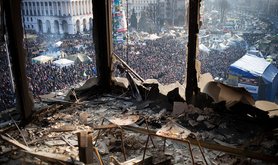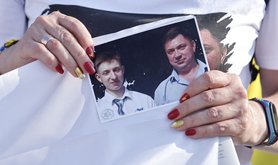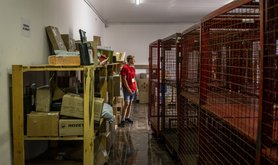
How HBO’s miniseries showed Russia’s Facebook generation that they too are children of Chernobyl
Why the Chernobyl series resonates in Russia today.

How would have events at Chernobyl developed if the Internet had existed in 1986? First, we would have seen rumours spreading on Facebook and short messages on anonymous Telegram channels saying things like “something somewhere has exploded”. This would have been followed by a couple of fuzzy photos on Instagram of a glow against a dark sky. Then perhaps a livestream on YouTube from a Pripyat rooftop where you would have heard the sounds of sirens, but not been able to make out anything precise. Then the hashtag #Chernobyl would have appeared as trending on Twitter. We would have started getting reports that the Internet was blocked in the incident area – but this would not have halted the flow of information, and only stirred up more rumours. A bit later, environmental and urban activists would have begun to share data from networks of sensors deployed for environmental monitoring. A dedicated group for eyewitnesses would have appeared on the Vkontakte social network. Then someone would have created a dedicated web page to collect information from various sources. Finally, a few hours later, the authorities would have been compelled to make a statement, something short like “there is no serious danger” or ”the situation is under complete control”. Journalists from Russian federal TV channel would have been allowed into the power station to report on the effective incident response measures. Perhaps a well-known blogger would also have been invited as a part of the official pool.
With new information technologies, a repeat of the kind of information blockade - when the Soviet authorities kept quiet about the disaster - that was set up around Chernobyl would hardly be possible today. But the unprecedented scale of user reactions in the Russian-speaking segment to HBO’s TV miniseries Chernobyl has shown that the story of the accident goes deeper than the question of historical truth. It would seem that the events of April-May 1986 have already entered the history books; information about what happened to Reactor No.4 at Chernobyl is publicly available. A whole range of documentaries have been produced in Ukraine, Russia and elsewhere. Many documents have been declassified, and hundreds of participants in the events have recounted their numerous versions of what happened. Yet HBO’s Chernobyl series still “exploded” the social networks.
For the Russian audience, perhaps not always consciously, the main theme of Chernobyl was not the events of the past, but the forces of invisibility that are still at work today
Of course, any attempt by outside observers to tell us a version of our history is controversial and inevitably leads to a discussion of historical authenticity. Particular attention is paid to how far external observers are able to avoid stereotypes, understand the everyday life and values of the main characters involved, or show the cognitive complexity of their relationships. These issues were much discussed recently, in both Russian and foreign media.
Yet alongside all this, it is difficult to ignore the fact that the miniseries’ American creators have managed to inspire something beyond a rational analysis of whether certain facts were accurate or not. Many social network users describe watching the series in “a state of shock” and with “a lump in my throat”. Some mentioned suffering from insomnia and experiencing extreme stress. Others, after watching the first episode, wrote that they could not watch any more.
In her book The Politics of Invisibility: Public Knowledge about Radiation Health Effects after Chernobyl, Olga Kuchinskaya draws attention to the fact that “because radiation is imperceptible, one’s experience of it is always mediated” - whether via radiation maps, media, different forms of visualisation or narrative. These forms of representation are, in effect, the way in radiation becomes visible. The question is how are they created. According to Kuchinskaya, waves of “visibility” and “invisibility” overtake us many years after a catastrophe. The “production of visibility” is in conflict with the “production of invisibility” – and the victor in this conflict depends on the resources available to supporters and opponents of visibility.

The invisibility described by Kuchinskaya is not necessarily an absence or concealment of facts. On the contrary, sometimes a documentary that gives a rational description of a particular historical event, presented as occurring “not here” and “not to us”, is part of a “policy of invisibility”.
A statement that an event has happened – such as President Putin’s comment on the Kursk submarine disaster in 2000 (“It sank”) – may illustrate precisely how describing a crisis can also make it invisible. Invisibility is a kind of narrative code that construes the distance between a viewer and an event. The production of invisibility constantly reproduces this distance in each new description. It is extremely difficult for anyone inside the system of production to get beyond the limits of this description. This is why the answer to the question that everyone has been asking (“Why couldn’t we have made this series?”) is: only outsiders can see the invisible sides of our life.
This “politics of invisibility” has served not to construct an objective knowledge of what radiation is, but to give people a feeling of personal safety. Ulrich Beck, the German scholar who developed the concept of a “risk society”, described the Chernobyl disaster as “an anthropological shock” that showed us that “none are so blind to a danger as those who continue to trust their own eyes”.
HBO’s Chernobyl series was able to tell the story of the tragedy in such a way that if we measured our emotions with a dosimeter, it would have shown them going wild. In effect, we received a dose of Chernobyl radiation 30 years after the event sitting in front of our own television screens. In fact, the series has become the catalyst for post-traumatic syndrome. The effect has been especially strong for those who were children when the Chernobyl events happened. The series, shot by Americans, showed the Russian Facebook generation that we are all “children of Chernobyl”.
Chernobyl has succeeded in undermining the “politics of invisibility” that survived the collapse of the USSR, just like the radiation itself. And social networks have multiplied the force of this shock wave several times over. The public reaction has also become a mechanism for disseminating information about the series. The scale and nature of the reaction to Chernobyl reflects not so much the production level of the series (which was very high), but rather just how effective the previous policy of silencing disasters was. The half-life of silence is sometimes longer than the half-life of radioactive atoms. The American series, with all its inevitable historical inaccuracies, was able to show Russian-speaking viewers that Chernobyl is here and now, and concerns them.
This offensive by the “forces of visibility”, in the form of the HBO series, also mobilised opposing forces. The protective “machine of invisibility” started to operate again. The outburst of criticism of the series – which comes down to an argument that this is another act of information warfare against Russia – was reminiscent of attempts to hide the scale of the tragedy more than 30 years ago. This criticism was followed by appeals to Roskomnadzor, the Russian state communication watchdog, to ban the series, as well as demands that its creators be tried for ideological manipulation and libel.
Apparently, the real subject of the series was not Chernobyl. It touched on one of the Russian state’s greatest vulnerabilities, inherited from the Soviet Union – their lack of communication skills in crisis situations.

Crisis situations are always tests of the relationship between state institutions and society. It is these situations that play a major role in determining the vector of this relationship. According to crisis communications researcher Sergey Samoylenko, the Russian authorities often play a dual role: they are not only crisis managers, but also producers of risk. The failure of crisis communications policies often becomes the source of a new crisis. The history of modern Russia is largely the history of such crises, or, to be more precise, the history of how crises associated with natural and human-made disasters have become a crisis of the relationship between government and society.
This can be seen in the Kursk submarine tragedy, which was reduced by the Russian president to two words (“It drowned”) that have become a symbol of the production of invisibility. It can also be seen in the 2002 Moscow theatre siege or the Beslan school siege in 2004, where the production of invisibility took on a new force. (For example, the scandal that followed the dismissal of Izvestia's editor-in-chief Raf Shakirov after what was deemed to be excessively emotional coverage of the Beslan events.) A topic of particular interest to producers of invisibility is the number of victims, whether dead or injured, resulting from an accident, natural disaster or participation in military conflict.
The reaction of the Russian authorities to wildfires that gripped the country in summer 2010 was a vivid illustration of how a force majeure situation is transformed into a crisis of relations between the state and society. While traditional media reported that the fires were under control, blogs and social networks allowed Russian citizens to see the real scale of the disaster on the basis of user-generated information. Moreover, the Internet allowed not only an increase in visibility and a holding to account of the state, but also a social mobilisation of response to the crisis, after the state failed to provide sufficient or adequate emergency response.
The Chernobyl accident is in the past, but the mechanisms for responding to crises have essentially not changed
Most states face serious difficulties in times of crisis, both natural and human-made. However, the fundamental difference lies precisely in how the state responds to this challenge.
This is not so much a question of what measures are being taken to deal with the crisis, but of how crisis communication is managed. In the Russian case, the policy of invisibility is not just a matter of hiding information or of a banal attempt to evade responsibility. The main problem lies in the fact that the state sees the main challenge as being not the disaster itself, but the popular demand for transparency and a mobilisation of resources to compensate for the state’s inefficiency. Thus, during the 2010 fires, the government’s attention shifted from the disaster to the social situation, often declaring volunteers to be the main threat. This also happened during last year’s tragic fire at the Winter Cherry shopping centre in Kemerovo, where relatives of victims were accused of actively trying to discredit the authorities.
The Chernobyl accident is in the past, but the mechanisms for responding to crises have essentially not changed. The same forces of invisibility continue to push human-made and natural disasters out of public consciousness. However, the conditions of the new information environment complicate the concealment of information and oblige these forces to change.
Today, invisibility production cannot be based on simple information isolation, as it was 30 years ago. Implementing invisibility now requires more stringent and repressive methods, as well as complex manipulation of information and discrediting of those who are the source of alternative information. In other words, where previously the state could limit itself to the effective control of information flows, today, in a crisis situation, the need to look for enemies has become much more significant.
For the Russian audience, perhaps not always consciously, the main theme of Chernobyl was not the events of the past, but the forces of invisibility that are still at work today. In a risk society whose contours – just like the spread of the Chernobyl radiation cloud – have begun to appear in our everyday lives, the main factor is not just a loss of security, but a fundamental need to come to terms with life in a world of growing uncertainty, where we are increasingly losing control over what is happening.
Survival in this kind of world depends on our confidence in those who, in the event of a crisis, will help us, if not to escape, then at least to understand what has happened. This type of confidence cannot be built in socio-political systems where the forces of invisibility are in charge. Thus, the effect of Chernobyl is not of a wave of the past reaching the present, but also a feeling of existential vulnerability in confronting the future – a renewed awareness that, in the case of tragedy, the only person you can rely on is yourself.
Read more
Get our weekly email





Comments
We encourage anyone to comment, please consult the oD commenting guidelines if you have any questions.